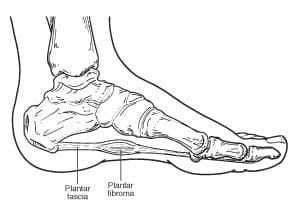
Are you experiencing pain or discomfort from a lump under the arch of your foot? You may be dealing with plantar fibromas, a condition that affects many individuals.
At AC Podiatry Adelaide, we see plantar fibromas regularly, and we’ve helped countless patients understand and manage this condition. Whether you’re dealing with a single plantar fibroma or multiple nodules, we’re here to guide you through everything you need to know about plantar fibroma treatment and management.
What Are Plantar Fibromas
Plantar fibromas are benign growths that develop within the plantar fascia, the thick band of tissue that runs from your heel to your toes. This tissue acts as your foot’s natural shock absorber, supporting your arch with every step you take. Unlike a single plantar fibroma, these conditions often present as multiple nodules along the arch, which is why specialised plantar fibroma management becomes so important.

While plantar fibromas are often painless initially, they can become uncomfortable as they develop or when pressure is applied through walking, standing for long periods, or wearing certain types of shoes.
Understanding whether you’re dealing with a single fibroma foot condition or multiple plantar fibromas helps us determine the most appropriate treatment approach for your specific situation.
Every case is different, and that’s why we take the time to thoroughly assess each patient’s individual circumstances.
Why Do Plantar Fibromas Develop
This is one of the most common questions we hear from our patients, and the answer involves several factors. Understanding these potential contributing factors helps our podiatrists team develop the most effective plantar fibroma management strategies for each patient.
Genetic predisposition – Family history may increase the likelihood of developing these conditions.
Repetitive stress to the plantar fascia from activities or biomechanical factors may also contribute to fibroma foot development.
Certain medications that affect connective tissue have been associated with plantar fibromas formation in some individuals.
Age-related factors show that plantar fibromas are more commonly observed in middle-aged adults.
Underlying health conditions such as diabetes also influences the development of fibroma in the foot.
Signs & Symptoms Of Plantar Fibromas
Plantar fibromas symptoms can vary quite significantly from one person to another, which is why professional assessment is so valuable.
Early Stage
You might notice a small, firm nodule in your foot arch. This could be a single fibroma foot presentation, or you might develop multiple plantar fibromas over time. Many patients tell us they first noticed it while massaging their feet or walking barefoot on hard surfaces. The lump typically doesn’t move when you press on it, which distinguishes it from other types of growth.
Progressive Stage
As they progress, you might start experiencing discomfort when walking barefoot, particularly on hard surfaces like tile or concrete. Certain footwear may become uncomfortable, especially shoes that put direct pressure on the arch area. The plantar fibromas may become more noticeable over time, and activities involving prolonged standing or walking can become increasingly challenging.
Advanced Stage
In more advanced cases, significant discomfort may begin to impact your daily activities. Multiple plantar fibromas can affect your overall foot function, and the fibroma in the foot may start influencing how you walk. This fibroma of foot condition might cause you to unconsciously adjust your gait, which can lead to compensatory issues in your knees, hips, or back.
Plantar Fibroma Management Approaches
There are various treatment options for plantar fibroma – conservative and advanced treatment options. Treatment effectiveness can vary between patients depending on factors including the characteristics of your condition, your overall health status, and how your body responds to different therapeutic approaches. So your podiatrist must discuss realistic expectations and work with you to find the most suitable path forward.
At AC Podiatry, we understand that what works well for one patient may not be the best choice for another, so we take the time to understand your specific situation before recommending any treatment approach.
Conservative Plantar Fibroma Management
Custom Orthotic Therapy
This approach includes custom orthotic devices designed to redistribute pressure away from plantar fibromas while providing arch support to reduce stress on fibromas. These devices accommodate fibroma foot presentations and support overall foot function when dealing with plantar fibromas. The effectiveness of orthotic therapy varies between patients and depends on factors such as fibroma size, location, and individual foot mechanics.
Physical Therapy Approaches
Specialised plantar fibroma management includes gentle stretching exercises to maintain your plantar fascia flexibility and strengthening programs for your foot and ankle muscles. Fibroma foot-specific mobilisation techniques may be incorporated alongside activity modification strategies to reduce stress on affected areas. Physical therapy approaches are typically most effective when combined with other treatment modalities.
Padding And Accommodations
Plantar fibromas-specific padding helps reduce pressure on affected areas, while foot accommodation devices can provide comfort during daily activities. Footwear modification recommendations focus on selecting appropriate shoes that don’t aggravate the condition and prevent further irritation during healing.
Advanced Treatment Options
For persistent plantar fibromas that don’t respond adequately to conservative measures, there are advanced treatment options available.
Steroid Injections
Corticosteroid injections may help reduce inflammation in the affected tissue, while specialised injection approaches may assist with fibrous tissue management. Success rates depend on factors including fibroma characteristics and patient-specific factors.
Extracorporeal Shockwave Therapy (ESWT)
The shockwave therapy can help break down fibrous tissue in plantar fibromas and stimulate a healing response. This treatment can reduce discomfort and inflammation while supporting fibroma foot function, though patient response varies, and multiple treatment sessions are typically required.
Surgical Considerations For Severe Cases
When conservative plantar fibroma management approaches are insufficient, surgical intervention may be discussed as an option for appropriate candidates. Plantar fasciectomy involves the removal of affected plantar fascia tissue containing plantar fibromas, while fibroma excision focuses on the targeted removal of individual fibroma foot nodules while preserving surrounding healthy tissue.
Extended recovery periods are required following surgical intervention, and plantar fibroma management post-surgical rehabilitation is necessary for optimal outcomes. Individual surgical outcomes vary significantly between patients based on multiple factors.
We encourage patients not to wait until symptoms become severe. Early intervention often leads to better outcomes and more treatment options.
Plantar Fibroma In Children – Specialised Pediatric Care
Plantar fibroma in children requires specialised attention and modified treatment approaches. While less common than adult presentations, plantar fibroma in child patients presents unique considerations that our pediatric specialists are trained to address.
Pediatric Assessment Considerations
Plantar fibroma in a child is often related to genetic factors, making family history evaluation an important part of assessment. Growth and development significantly impact fibroma foot progression in children, requiring ongoing monitoring and treatment plan adjustments.
Child-Appropriate Treatment Approaches
Gentle assessment approaches must be considered for the child’s comfort and cooperation during examination. Child-appropriate treatment approaches include conservative plantar fibroma management techniques that respect the developing foot structure.
Child-specific orthotic solutions are designed to accommodate growth while providing necessary support. Conservative approaches are prioritised for developing feet, with regular monitoring of fibroma foot development to ensure appropriate progression.
Plantar Fibroma Management Education
Family education for plantar fibroma in child cases includes understanding the genetic components of plantar fibromas and learning home care strategies. Activity modification guidance helps families make appropriate choices while long-term management planning ensures continuity of care as the child grows.
Prevention And Long-term Management
While we can’t always prevent plantar fibromas due to genetic factors, there are definitely strategies that can help reduce your risk or slow progression. Good footwear choices that don’t put excessive stress on your plantar fascia can make a real difference.
Regular foot health monitoring allows us to catch changes early, and addressing foot discomfort promptly can prevent minor issues from developing into more significant problems. Plantar fibroma management education helps you understand how to care for your feet and recognise when changes warrant professional attention.
Long-term care often involves regular podiatric check-ups, ongoing plantar fibromas assessment, and adapting strategies as your condition or lifestyle changes over time.
Why Choose AC Podiatry For Plantar Fibroma Care
Professional assessment is necessary to determine the most appropriate treatment for your specific condition.
Our Podiatrists team has developed specialised expertise in plantar fibromas assessment and treatment, and we’ve invested in advanced diagnostic capabilities that allow us to perform thorough fibroma foot evaluations.
We genuinely care about getting you the best possible outcomes. Every fibroma in the foot case receives a personalised treatment plan because we know that what works for one person might not be the right approach for another.
Searching for a bupa podiatrist to help with plantar fibromas? AC Podiatry is your trusted bupa podiatry Adelaide. We ensure you receive optimal care coordination and reduced out-of-pocket expenses for eligible services.
Don’t let plantar fibromas limit your daily activities. With multiple Podiatry clinics across Adelaide and the Eastern suburbs, we’re never too far away when you need us. Book a call today to speak with our professional podiatrist.
